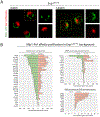Nuclear mRNA metabolism drives selective basket assembly on a subset of nuclear pore complexes in budding yeast
- PMID: 36220102
- PMCID: PMC10300651
- DOI: 10.1016/j.molcel.2022.09.019
Nuclear mRNA metabolism drives selective basket assembly on a subset of nuclear pore complexes in budding yeast
Abstract
To determine which transcripts should reach the cytoplasm for translation, eukaryotic cells have established mechanisms to regulate selective mRNA export through the nuclear pore complex (NPC). The nuclear basket, a substructure of the NPC protruding into the nucleoplasm, is thought to function as a stable platform where mRNA-protein complexes (mRNPs) are rearranged and undergo quality control prior to export, ensuring that only mature mRNAs reach the cytoplasm. Here, we use proteomic, genetic, live-cell, and single-molecule resolution microscopy approaches in budding yeast to demonstrate that basket formation is dependent on RNA polymerase II transcription and subsequent mRNP processing. We further show that while all NPCs can bind Mlp1, baskets assemble only on a subset of nucleoplasmic NPCs, and these basket-containing NPCs associate a distinct protein and RNA interactome. Taken together, our data point toward NPC heterogeneity and an RNA-dependent mechanism for functionalization of NPCs in budding yeast through nuclear basket assembly.
Keywords: Mlp1; NPC heterogeneity; basket accessory interactome; mRNA export; mRNA processing; nuclear basket; nuclear compartmentalization; nuclear pore complex; nucleolus; poly(A) transcripts.
Copyright © 2022 Elsevier Inc. All rights reserved.
Conflict of interest statement
Declaration of interests The authors declare no competing interests.
Figures








Similar articles
-
Nuclear basket proteins regulate the distribution and mobility of nuclear pore complexes in budding yeast.Mol Biol Cell. 2024 Nov 1;35(11):ar143. doi: 10.1091/mbc.E24-08-0371. Epub 2024 Sep 25. Mol Biol Cell. 2024. PMID: 39320946 Free PMC article.
-
The nuclear basket mediates perinuclear mRNA scanning in budding yeast.J Cell Biol. 2015 Dec 21;211(6):1131-40. doi: 10.1083/jcb.201503070. J Cell Biol. 2015. PMID: 26694838 Free PMC article.
-
Nuclear pore complex acetylation regulates mRNA export and cell cycle commitment in budding yeast.EMBO J. 2022 Aug 1;41(15):e110271. doi: 10.15252/embj.2021110271. Epub 2022 Jun 23. EMBO J. 2022. PMID: 35735140 Free PMC article.
-
Choosing the right exit: How functional plasticity of the nuclear pore drives selective and efficient mRNA export.Wiley Interdiscip Rev RNA. 2021 Nov;12(6):e1660. doi: 10.1002/wrna.1660. Epub 2021 May 2. Wiley Interdiscip Rev RNA. 2021. PMID: 33938148 Review.
-
Into the basket and beyond: the journey of mRNA through the nuclear pore complex.Biochem J. 2020 Jan 17;477(1):23-44. doi: 10.1042/BCJ20190132. Biochem J. 2020. PMID: 31913454 Review.
Cited by
-
The molecular architecture of the nuclear basket.Cell. 2024 Sep 19;187(19):5267-5281.e13. doi: 10.1016/j.cell.2024.07.020. Epub 2024 Aug 9. Cell. 2024. PMID: 39127037 Free PMC article.
-
Implications of a multiscale structure of the yeast nuclear pore complex.Mol Cell. 2023 Sep 21;83(18):3283-3302.e5. doi: 10.1016/j.molcel.2023.08.025. Mol Cell. 2023. PMID: 37738963 Free PMC article.
-
Pan-cellular organelles and suborganelles-from common functions to cellular diversity?Genes Dev. 2024 Mar 22;38(3-4):98-114. doi: 10.1101/gad.351337.123. Genes Dev. 2024. PMID: 38485267 Free PMC article. Review.
-
Nuclear basket proteins regulate the distribution and mobility of nuclear pore complexes in budding yeast.Mol Biol Cell. 2024 Nov 1;35(11):ar143. doi: 10.1091/mbc.E24-08-0371. Epub 2024 Sep 25. Mol Biol Cell. 2024. PMID: 39320946 Free PMC article.
-
Nuclear basket proteins Mlp1 and Nup2 drive heat shock-induced 3D genome restructuring.bioRxiv [Preprint]. 2025 Jan 2:2025.01.01.631024. doi: 10.1101/2025.01.01.631024. bioRxiv. 2025. Update in: J Biol Chem. 2025 Aug 6:110568. doi: 10.1016/j.jbc.2025.110568. PMID: 39803495 Free PMC article. Updated. Preprint.
References
-
- Aguilar L-C, Paul B, Reiter T, Gendron L, Rajan AAN, Montpetit R, Trahan C, Pechmann S, Oeffinger M, and Montpetit B (2020). Altered rRNA processing disrupts nuclear RNA homeostasis via competition for the poly(A)-binding protein Nab2. Nucleic Acids Res 48, 11675–11694. 10.1093/nar/gkaa964. - DOI - PMC - PubMed
Publication types
MeSH terms
Substances
Grants and funding
LinkOut - more resources
Full Text Sources
Molecular Biology Databases

